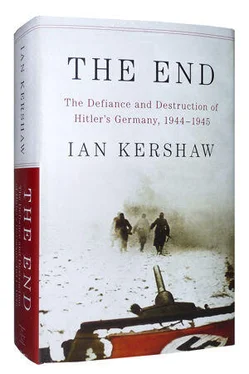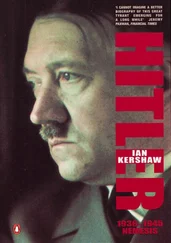68. Henke, p. 845.
69. Henke, p. 846.
70. Haase, p. 86.
71. ‘Führer-Erlasse’ 1939–1945 , ed. Martin Moll, Stuttgart, 1997, p. 483; also printed in Müller and Ueberschär, pp. 163–4. For the operation of the summary courts martial, see Messerschmidt, Die Wehrmachtjustiz 1933–1945 , pp. 411–15; and also Jürgen Zarusky, ‘Von der Sondergerichtsbarkeit zum Endphasenterror: Loyalitätserzwingung und Rache am Widerstand in Zusammenbruch des NS-Regimes’, in Cord Arendes, Edgar Wolfrum and Jörg Zedler (eds.), Terror nach Innen: Verbrechen am Ende des Zweiten Weltkrieges , Göttingen, 2006, p. 114. The extension to the ‘flying courts martial’ is indicated in Bormann’s circular to the Gauleiter, NS6/354, fo. 88 v, RS 123/45g, 9.3.45.
72. See Henke, pp. 846ff., for examples of their practice.
73. Ulrich Herbert, Fremdarbeiter: Politik und Praxis des ‘Ausländer-Einsatzes’ in der Kriegswirtschaft des Dritten Reiches , Bonn, 1985, pp. 270–71, p. 430 n. 3.
74. BAB, R43II/650c, fos. 119–25, Kampfkommandant Reichskanzlei, Führerbefehl v. 4.2.45 über ‘Verteidigung der Reichskanzlei bei inneren Unruhen’, 4–10.2.45.
75. NAL, WO208/5622, fo. 122A, 29.8.44. The general in question, Dietrich von Choltitz, had been the Wehrmacht commander in Paris at the time of the city’s liberation in August 1944.
76. Jill Stephenson, Hitler’s Home Front: Württemberg under the Nazis , London, 2006, p. 285.
77. Von Kardorff, pp. 208–9 (30.11.44).
78. Herbert, pp. 327–35; Andreas Heusler, ‘Die Eskalation des Terrors: Gewalt gegen ausländische Zwangsarbeiter in der Endphase des Zweiten Weltkrieges’, in Arendes, Wolfrum and Zedler, pp. 172–82.
79. Quoted Gerhard Paul and Alexander Primavesi, ‘Die Verfolgung der “Fremdvölkischen”: Das Beispiel der Staatspolizeistelle Dortmund’, in Gerhard Paul and Klaus-Michael Mallmann (eds.), Die Gestapo: Mythos und Realität , Darmstadt, 1995, p. 398.
80. Gerhard Paul, ‘ “Diese Erschießungen haben mich innerlich gar nicht mehr berührt”: Die Kriegsendphasenverbrechen der Gestapo 1944/45’, in Gerhard Paul and Klaus-Michael Mallmann (eds.), Die Gestapo im Zweiten Weltkrieg: ‘Heimatfront’ und besetztes Europa , Darmstadt, 2000, p. 548.
81. Paul and Primavesi, p. 399; also Paul, p. 549; Bessel, p. 55.
82. Cited Paul, p. 550.
83. For the special circumstances in Cologne, see Bernd-A. Rusinek, ‘ “Wat denkste, wat mir objerümt han”: Massenmord und Spurenbeseitigung am Beispiel der Staatspolizeistelle Köln 1944/45’, in Paul and Mallmann, Die Gestapo: Mythos und Realität , pp. 402–16.
84. Paul, pp. 553–7; Herbert, pp. 336–7; Nikolaus Wachsmann, Hitler’s Prisons: Legal Terror in Nazi Germany , New Haven and London, 2004, pp. 332–3.
85. IWM, F.2, AL 1753, statistics from SS-Wirtschafts-Verwaltungshauptamt, totalling 511,537 men and 202,674 women, 714,211 in all on 15 January 1945, guarded by 37,674 men and 3,508 women; Martin Broszat, ‘Nationalsozialistische Konzentrationslager 1933–1945’, in Hans Buchheim et al. , Anatomie des SS-Staates , Olten and Freiburg im Breisgau, 1965, vol. 2, p. 159; Wachsmann, p. 395; Daniel Blatman, ‘Die Todesmärsche—Entscheidungsträger, Mörder und Opfer’, in Ulrich Herbert, Karin Orth and Christoph Dieckmann (eds.), Die nationalsozialistischen Konzentrationslager , vol. 2, Göttingen, 1998, p. 1067; Gerald Reitlinger, The Final Solution , Sphere Books edn., London, 1971, pp. 501, 639 n. 30; Peter Longerich, Holocaust: The Nazi Persecution and Murder of the Jews , Oxford, 2010, p. 418.
86. Felix Kersten, The Kersten Memoirs, 1940–1945 , London, 1956, p. 277 (12.3.45), and also p. 275 (2.3.45); and DZW , 6, p. 643 (where Himmler’s reference to a Führer order is dated 5.3.45). Himmler saw Kersten at the sanitorium in Hohenlychen every morning from 4 to 13 March (BAB, NS19/1793, Termine des Reichsführer-SS, fos. 5–15). No specific written order from Hitler for the murder of camp prisoners has come to light, though a general—almost certainly verbal—directive that prisoners were not to be left behind on approach of the enemy seems to have been known to high-ranking SS officers, and may well have been used as an implicit order to kill those in their charge if there was a danger of the camp falling into enemy hands. In practice, however, there were only a few cases of the murder of all prisoners before evacuation. The actual decisions over life and death for the prisoners were taken lower down the leadership ladder, at the local level.—Daniel Blatman, ‘Rückzug, Evakuierung und Todesmärsche 1944–1945’, in Wolfgang Benz and Barbara Distel (eds.), Der Ort des Terrors: Geschichte der nationalsozialistischen Konzentrationslager , vol. 1, Munich, 2005, pp. 300–301.
87. Karin Orth, Das System der nationalsozialistischen Konzentrationslager: Eine politische Organisationsgeschichte , Hamburg, 1999, pp. 272–3.
88. No explicit written order to this effect has been found (other than for prisons in the General Government of Poland).—Paul, pp. 550–51 and nn. 31–3; Gabriele Hammermann, ‘Die Todesmärsche aus den Konzentrationslagern 1944/45’, in Arendes, Wolfrum and Zedler, pp. 122–3, 125; Blatman, ‘Die Todesmärsche’, pp. 1068–70, 1086; Eberhard Kolb, ‘Die letzte Kriegsphase: Kommentierende Bemerkungen’, in Herbert, Orth and Dieckmann, p. 1131; DZW , 6, p. 643.
89. Kommandant in Auschwitz: Autobiographische Aufzeichnungen des Rudolf Höss , ed. Martin Broszat, pb. edn., Munich, 1963, p. 145 n. 1; Saul Friedländer, The Years of Extermination: Nazi Germany and the Jews, 1939–1945 , London, 2007, p. 648; Daniel Blatman, ‘The Death Marches, January–May 1945: Who Was Responsible for What?’, YVS , 28 (2000), pp. 168–71, 198–9.
90. Rudolf Höss gives a vivid impression of the chaos in Kommandant in Auschwitz , pp. 145–7.
91. Walter Schellenberg, Schellenberg , pb. edn., London, 1965, pp. 167–70; Peter R. Black, Ernst Kaltenbrunner: Ideological Soldier of the Third Reich , Princeton, 1984, pp. 228–30; Friedländer, pp. 621–5, 647–8; Peter Longerich, Heinrich Himmler: Biographie , Munich, 2008, pp. 728–30; Heinz Höhne, The Order of the Death’s Head , London, 1972, pp. 524–5; Hammermann, p. 126; Yehuda Bauer, Jews for Sale? Nazi-Jewish Negotiations, 1933–1945 , New Haven, 1994, pp. 239–51; Simone Erpel, Zwischen Vernichtung und Befreiung: Das Frauen-Konzentrationslager Ravensbrück in der letzten Kriegsphase , Berlin, 2005, pp. 97–154 (where the number of camp prisoners saved by such action by the end of the war, most notably through the Swedish initiative, is given as 15,345, of whom 7,795 were Scandinavians—a proportion which, however, as she points out, underrates the number of non-Scandinavians rescued). Intelligence reports to the western Allies claimed that the negotiations about the liberation of a number of Jews had caused a ‘sensation’ in Berlin, and had been condemned by leading Nazis, including Julius Streicher.—NAL, WO219/1587, fo. 734, SHAEF report, 25.2.45.
92. Blatman, ‘Die Todesmärsche’, pp. 1069–72; and Daniel Blatman, Les Marches de la mort: La dernière étape du génocide nazi, été 1944-printemps 1945 , Paris, 2009, pp. 96–100, 127–31.
93. Orth, p. 279.
94. Wachsmann, pp. 324–5.
95. Wachsmann, pp. 325–33.
96. Laurence Rees, Auschwitz: The Nazis and the ‘Final Solution’ , London, 2005, p. 301, based upon figures supplied by the Auschwitz-Birkenau Museum.
97. Sybille Steinbacher, Auschwitz: A History , London, 2005, p. 124.
Читать дальше












